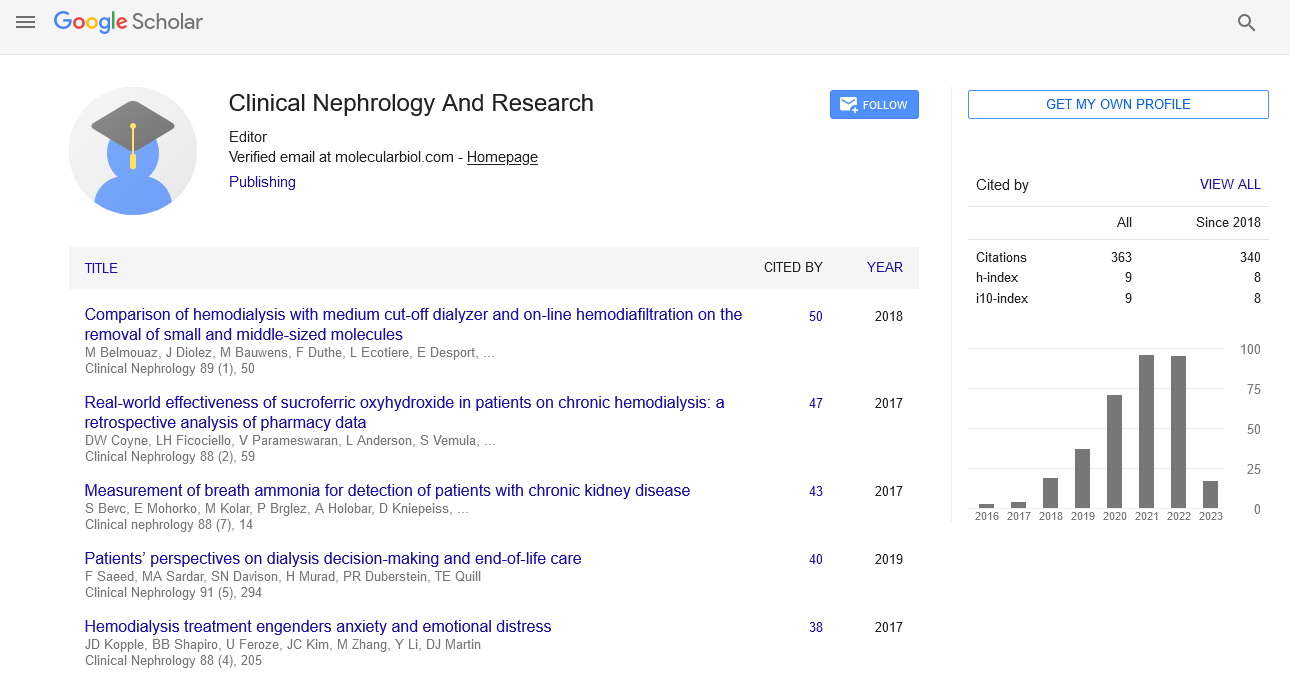Treatment for type 1 primary oxalate uric aciduria
Received: 05-May-2024, Manuscript No. PULCNR-24-6406; Editor assigned: 08-May-2024, Pre QC No. PULCNR-24-6406 (PQ); Reviewed: 23-May-2024 QC No. PULCNR-24-6406; Revised: 05-Jul-2024, Manuscript No. PULCNR-24-6406 (R); Published: 30-May-2024
Citation: Furuncuoglu U. Treatment for type 1 primary oxalate uric aciduria. Clin Nephrol Res 2023;7(1):1.
This open-access article is distributed under the terms of the Creative Commons Attribution Non-Commercial License (CC BY-NC) (http://creativecommons.org/licenses/by-nc/4.0/), which permits reuse, distribution and reproduction of the article, provided that the original work is properly cited and the reuse is restricted to noncommercial purposes. For commercial reuse, contact reprints@pulsus.com
Introduction
For Primary Hyperoxaluria type 1 (PH1), high fluid intake and crystallization inhibitors are utilised as supportive therapies. A small percentage of people with the PH1 genotypes c.508G>A and c.454T>A will react to pyridoxine by experiencing a more than 30% drop in urinary oxalate excretion. Pyridoxine's effectiveness varies, and in some people, urinary oxalate levels may return to normal. 2020 saw the approval of the first targeted medication for PH1, which reduced urinary oxalate using an RNA interference agent. Such drugs may significantly alter PH1 treatment strategies and long-term outcomes.
Currently, PH1 frequently results in End-Stage Kidney Disease (ESKD) and a decline in renal function. Urinary oxalate clearance decreases with renal failure, which leads to multisystem oxalate deposition (oxalosis), which most frequently affects the bones, eyes, heart, and skin. Additionally, little is known about the treatments social workers use to address psychological issues in various stages of renal failure, as well as their impacts on patients and families.
The objectives of this retrospective audit are to identify and compare the social worker treatments for patients with kidney failure given the lack of information on social worker treatments for patients with kidney failure and the significance of psychological support for persons diagnosed with kidney failure for both patients and health care providers. The social worker treatments needed in these two phases as well as the social worker interventions recommended during phases 1 and 2 of sickness are described, as well as the psychological problems affecting patients throughout the pre- KRT or start of KRT and KSPC stages of the kidney failure disease trajectory.
Description
We conducted a secondary data audit on patients who had psychosocial assessments and were receiving KRT (phase 1) or KSPC (phase 2) in an Australian setting between March 2012 and March 2020. 79 individuals, ranging in age from 70 to 12, had at least two psychosocial evaluations, one during each of the two phases of the illness.
Between phase 1 and phase 2 social worker evaluations, there was a median gap of 522 (116943) days. An adjustment to illness and treatment was the most prevalent psychological problem identified in phase 1 (90%), which fell to 39% in phase 2. Between phases 1 and 2, there was a sharp increase in the demand for elderly care services. The social worker's psychosocial interventions, which included supportive counseling, education and information, and referrals, greatly increased in phase 2.
In this multicenter study analyzing the variations in psychosocial needs of kidney failure patients in the pre or start of KRT and KSPC stages of disease that require social worker intervention, we found that patients had unique requirements that require different social work treatments.
In addition to routine counseling and education on KRT, patients in the KSPC phase are more likely to need carer assistance, help from aged care organizations, and medical referrals. The results of this retrospective audit show and substantiate that participants in phase 1 had significant psychological suffering as a result of renal failure and the commencement of KRT in many areas of their everyday life. Patients' needs change during the supportive and palliative stages of their disease, but they still have a heavy emotional burden and have adaptive needs. The results emphasise the value of social work intervention in alleviating psychosocial worries and lowering internal and external barriers to preserving physical, social, and emotional well-being. The interconnectedness of the physical, psychological, and social impacts of kidney failure on Quality of Life (QoL) highlights the need for an all-encompassing and integrated strategy to provide renal support services.
The study's methodological flaws must be taken into consideration while analyzing the study's results. The study's capacity to be generalized to other situations may be constrained by the extremely small sample size from a particular circumstance. The study's retrospective design also prevented it from examining the impact of the identified psychosocial variables or the involvement of social workers on other patient-reported and clinical outcomes.
Furthermore, further research to ascertain the impact of social worker treatments on a range of psychosocial presentations was not feasible due to the limited and secondary nature of the data. Finally, it is important to emphasise that less than half of the study participants were born in Australia, and it is likely that immigrant community cultural traits had an impact on the findings. We found that renal failure patients who are approaching or beginning KRT have significant psychological discomfort in many aspects of their daily life and that nephrology social workers can help.
Conclusion
The tremendous emotional burden and adaptive expectations that are placed on patients as they move closer to KSPC consultation change dramatically. Treatment for various psychosocial issues and the removal of internal and external obstacles to sustaining one's physical, social, and emotional well-being may be achieved through social work psychosocial intervention. However, there is still a lack of knowledge regarding the emotional impact before patients start KRT as well as during the supportive and palliative care stages. To ascertain the effect of social work interventions on patient reported outcomes, more research is also required.





